There are clearly households experiencing financial stress: RBA assistant governor
GUEST OBSERVER
RBA assistant governor Michele Bullock address to the Responsible Lending and Borrowing Summit.
Thank you for the opportunity to be here today. The title of the summit, ‘Responsible Lending and Borrowing – Risk, Responsibility and Reputation’, really struck a chord with me because there has been much discussion over the past few years about housing prices and the increasing debt being taken on by the household sector.
The Reserve Bank's interest in this area springs from both its responsibility for monetary policy and its mandate for financial stability. From the perspective of monetary policy, high debt levels will influence the calibration of interest rate changes. The more debt households have, the more sensitive their cash flow, and hence consumption, is likely to be to a rise in interest rates. Households with higher debt levels may also sharply curtail their consumption in response to an adverse shock such as rising unemployment or large falls in house prices, amplifying any economic downturn. My focus today, however, is on the potential risks to financial stability from this build up in debt. One of the key issues we have been focusing on is the extent to which rising household debt might presage stress in household budgets, with flow on effects to financial stability and ultimately to the economy. There has been a lot said and written about this issue in recent times, using a multitude of data sources and anecdotes. What I hope to do today is to put this information into some context to provide a balanced view on the current and prospective levels of household financial stress, and hence the implications for financial stability.
I want to make a couple of points at the outset. The first is that there are clearly households in Australia at the moment that are experiencing financial stress. By focusing on whether financial stress has implications for financial stability, I am not in any way playing down the difficulties some households are experiencing. There is a very real human cost of financial stress.
Second, some of the most financially stressed households are those with lower incomes which typically rent rather than borrow to buy a home. Access to suitable affordable housing for this group is clearly an important social issue. But given the topic of this summit and the potential link to financial stability, I am going to focus in this talk on household mortgage debt and the potential for financial stress resulting from this.
What is Financial Stress?
Definitions of financial stress are many and varied. One definition could be where a household fails to pay its bills or scheduled debt repayments on time because of a shortage of money. This is quite narrow – it captures only those households for which stress has already manifested in missed payments. A much broader definition of financial stress might be a situation where financial pressures are causing an individual to worry about their finances, or where an individual cannot afford ‘necessities’. These definitions might be good leading indicators of failures to meet debt repayments or defaults. So there is a role for a variety of indicators of stress.
One way of thinking about financial stress is in terms of a spectrum or a pyramid, running from mild stress to severe stress (Graph 1). At the mild end, the base of the pyramid, people may perceive that they are financially stressed when they have to cut back on some discretionary expenditure, such as a holiday or a regular meal out. Slightly further up the pyramid, they may not be able to pay bills on time, or might have to seek emergency funding from family. At the top of the pyramid – severe financial stress – a household might be unable to meet mortgage repayments or ultimately be facing foreclosure or bankruptcy.
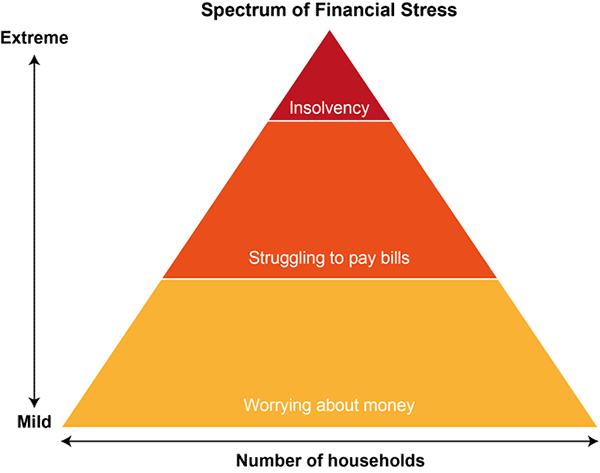
The pyramid is wider at the bottom than the top reflecting the fact that there will always be more households in milder stress than in severe stress. For some households experiencing milder stress their circumstances might deteriorate and they will move to a more severe form of financial stress. But some others might continue to restrain spending on discretionary items so as to meet essential payments. Others might experience a change in circumstances that improves their financial position.
Triggers and Protections from Financial Stress
Most people don't consciously set out to put themselves in a position of financial stress. Sometimes people might choose to stretch themselves initially in taking out a loan, perhaps even putting themselves into mild, temporary financial stress. But they would typically be doing so on the expectation that it will become more manageable over time as their income rises. More serious financial stress often only comes about by a combination of what turns out to be excessive debt and changed circumstances. A level of mortgage debt that looked manageable when it was taken out might become unmanageable if, for example, the primary income earner of a household becomes unemployed. Or if life circumstances change, such as through ill health, the birth of a child or breakdown of a relationship.
So what do conditions in the housing sector over the past few years suggest about the potential for financial stress? You are all familiar with the broad story. House prices have been rising rapidly, particularly in Sydney and Melbourne. At the same time, household mortgage debt has been rising while incomes have been growing relatively slowly. As a result, the average household mortgage debt-to-income ratio has risen from around 120 per cent in 2012 to around 140 per cent at the end of 2017 (Graph 2, left panel). Furthermore, the increasing popularity of interest-only loans over recent years meant that by early 2017, 40 per cent of the debt did not require principal repayments (Graph 3). A particularly large share of property investors has chosen interest-only loans because of the tax incentives, although some owner-occupiers have also not been paying down principal. This presents a potential source of financial stress if a household's circumstances were to take a negative turn.
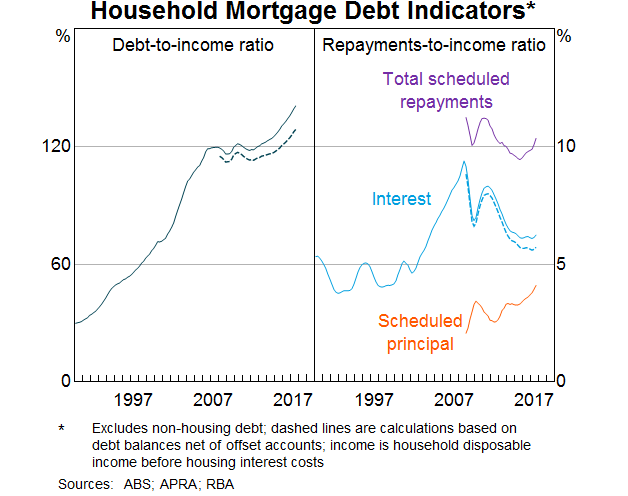
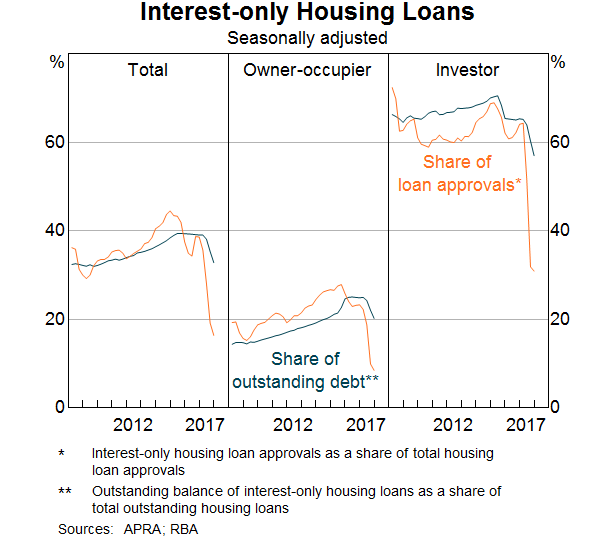
This is where lending standards come in. There is always a balance to be struck with lending standards. If they are too tight, access to credit will be unreasonably constrained, potentially impacting economic activity and restricting some households from making large purchases that they can afford. If they are too loose, however, borrowers and lenders could find risks building on their balance sheets which, if large enough, might have implications for financial stability. Over the past few years in Australia, regulators have been concerned that lending standards have erred on the more relaxed side. An exuberant housing market in some parts of the country and strong competition among lenders raised the question of whether financial institutions had been appropriately prudent in assessing a household's ability to meet repayments.
In response, a number of measures were implemented by APRA and ASIC to strengthen mortgage lending standards. These measures have helped improve the quality of lending over the past couple of years. But there is still a large stock of housing debt out there, some of which probably would not meet the more conservative lending standards currently being imposed. How large a risk does this pose to financial stability? It depends on a number of things, including how lax the previous lending standards were, how much of the stock was lent under less prudent standards and the repayment patterns of borrowers. One way of assessing the risk though is to look at the level and trajectory of mortgage stress.
Measures of Financial Stress
There is no single measure that captures the level of financial stress. There are comprehensive surveys, such as the survey of Household, Income and Labour Dynamics in Australia (HILDA) and the Survey of Income and Housing (SIH), that are methodologically robust, but are only available with a lag. A number of private sector surveys are more timely but it can be harder to assess whether their methodologies are well focused on financial stress. There is also information on non-performing loans, insolvencies and property repossessions that is fairly timely and reliable, but is only an indicator of pretty severe stress. I am going to talk through a few measures and see what they imply about the current level of mortgage stress among Australian households.
Let's start with some high-level data on debt and debt servicing. As I noted above, the average household mortgage debt-to-income ratio has been rising over recent years. In a sense, this is not really surprising. With historically low interest rates, households have been able to service higher levels of debt. Indeed, the debt-servicing ratio (defined as the scheduled principal and interest mortgage repayments to income ratio) has remained fairly steady at around 10 per cent despite the rise in debt (Graph 2, right panel). But these are averages. It is important to look at the distribution of this debt – are the people holding it likely to be able to service it?
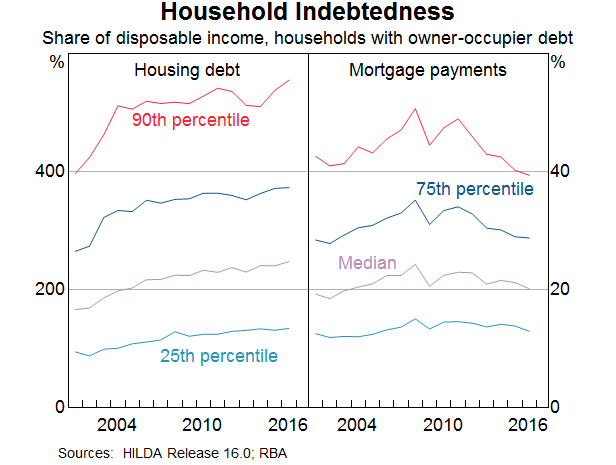
The HILDA survey provides information on the distribution of household indebtedness and debt servicing as a share of disposable income. Looking only at owner-occupier households that have mortgage debt, the survey suggests that the median housing debt-to-income ratio has risen steadily over the past decade to around 250 per cent in 2016 (Graph 4, left panel).[1]However, the median ratio of mortgage servicing payments to income has been fairly stable through time, remaining around 20 per cent in 2016 (Graph 4, right panel). In fact 75 per cent of households with owner-occupier debt had mortgage payments of 30 per cent or less of income, which is often used as a rough indicator of the limit for a sustainable level of mortgage repayments.[2] This suggests that, as recently as 2016, mortgage repayments were not at levels that would indicate an unusual or high level of financial stress for most owner-occupiers. But there is a significant minority for whom mortgage stress might be an issue.
Other data sources suggest that the number of households experiencing mortgage stress has fallen over the past decade. The Census data show that the share of indebted owner-occupier households for which actual mortgage payments (that is, required and voluntary payments) were at or above 30 per cent of their gross income declined from 28 per cent in 2011 to around 20 per cent in 2016. And the 2015/16 Household Expenditure Survey indicates that the number of households experiencing financial stress has steadily fallen since the mid 2000s.
Furthermore, a large proportion of indebted owner-occupier households are ahead on their mortgage repayments. We have highlighted this point in recent Financial Stability Reviews. Total household mortgage buffers – including balances in offset accounts and redraw facilities – have been rising over the past few years as households have taken advantage of falling interest rates to pay down debt faster than required. In 2017, total owner-occupier buffers were around 19 per cent of outstanding loan balances or around 2 ½ years of scheduled repayments at current interest rates (Graph 5, left panel)). There is some variation in buffers. While one-third of outstanding owner-occupier mortgages had at least two years' buffer, around one-quarter had less than one month (Graph 5, right panel). Not all of these loans, however, are necessarily vulnerable to financial stress. If households are building up other assets instead of building up mortgage buffers, they may still be well positioned to weather any change in circumstances.
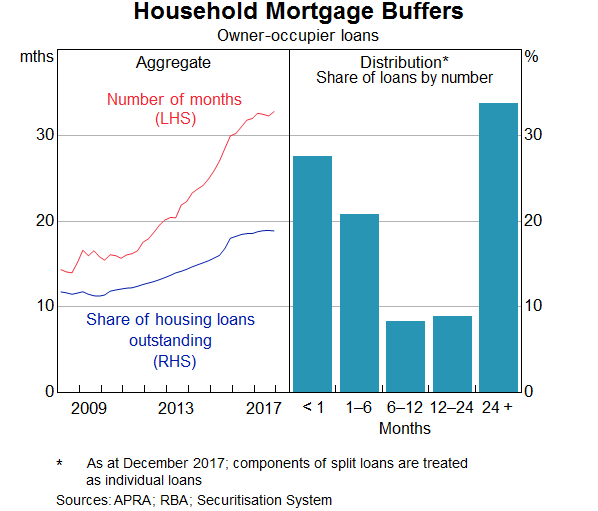
All of this suggests that a large proportion of households have some protection against financial stress. There are, however, some households that are more vulnerable, probably those with lower income who cannot afford prepayments or those with relatively new mortgages who have yet to make many inroads.
Another way of measuring financial stress is by asking survey respondents to self-assess. For example, a survey might ask about the respondent's ability to meet payments, the type of financial stress they have experienced, or whether they have had difficulty raising money in an emergency.
The HILDA survey also provides some information on this. In general, measures such as these indicate that financial stress for owner-occupiers with mortgage debt has not changed much over the past decade, and is actually lower than in the early 2000s. Around 12 per cent of such households indicated that they would expect difficulty raising funds in an emergency in 2016 (Graph 6). The survey also asks people what sort of financial difficulties they had experienced over the past twelve months. For example, did they have difficulty paying a mortgage or bills on time? Were they unable to heat their home or did they have to go without meals? Did they have to ask for financial assistance from family or a welfare agency? A bit less than 20 percent of owner-occupier households said they had experienced at least one difficulty in the past 12 months, but only 5 per cent reported experiencing three or more of these difficulties. Most of these indicators also suggest that, in line with some of the earlier data I noted, stress has declined since 2011, which probably largely reflects the fall in interest rates since that time.
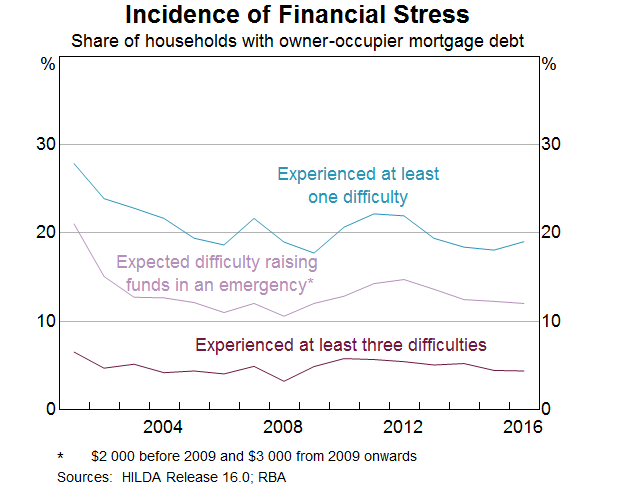
Unfortunately, while the HILDA and SIH data are rich in terms of the information provided, they are not very timely. We have, for example, only just received the 2016 data. So much of the discussion on household stress relies on more timely private surveys. These surveys measure stress in different ways. Some focus specifically on mortgage stress. Others look at housing affordability, including for renters. And still others attempt to measure financial ‘comfort’ more broadly than just housing. Many of these suggest that housing stress has been increasing over the past year or so.
Looking at the history for which we have data for both the private and comprehensive surveys, it is a little difficult to reconcile their findings. But there do seem to be some methodological differences that mean some surveys might overstate financial stress somewhat. For example, in some of these surveys, self-assessed living expenses are used. If households include discretionary expenditure that could be cut back in an emergency, the amount of income available to meet scheduled repayments might be understated. Furthermore, if actual mortgage repayments are used, those households that are routinely ahead of their payments schedule might be assessed as having little spare income for emergencies when in reality they have been building up buffers and have surplus cash flow.
Most of the measures I have discussed so far are more in the nature of potential financial stress. For some households this will likely turn out to be temporary until their circumstances change. But others may find themselves in a prolonged period of belt tightening or, in the extreme, having to sell their property or default on their payments. In this latter case, financial stress will show up in non-performing loans on banks' balance sheets and perhaps even in property repossessions or bankruptcies. What do these data tell us?
Banks' non-performing housing loans have been trending upwards over the past few years, although they remain very low in absolute terms at around 0.8 per cent of banks' domestic housing loan books (Graph 7). Much of this rise is attributable to a rise in non-performing loans in the mining-exposed states of Western Australia and Queensland – not unexpected given the large falls in employment and housing prices in some of these regions.
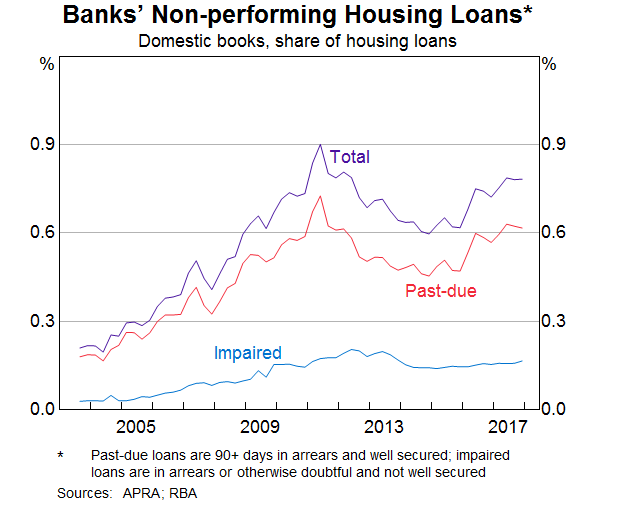
Personal insolvencies as a share of the population have remained fairly stable over the past few years. Applications for property possession as a share of the total dwelling stock have generally declined since 2010, with the exception being Western Australia (Graph 8). This indicates that financial stress has a high cyclical component, and there are likely to be some regions of the country that are in more difficult times than others. But the focus for financial stability considerations is largely a national rather than a regional perspective.
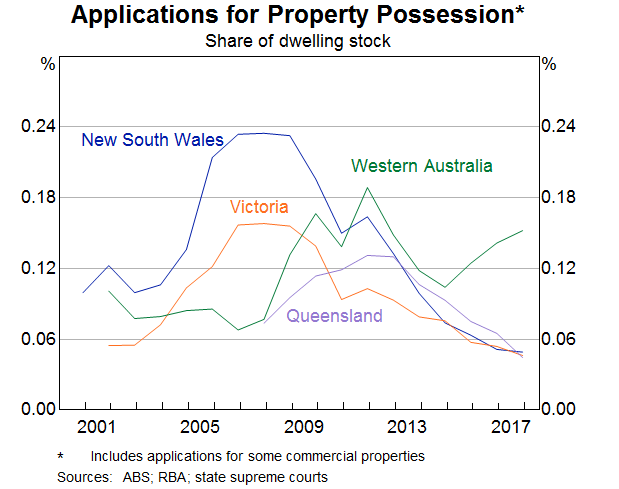
So my overall interpretation of these myriad pieces of information is that, while debt levels are relatively high, and there are owner-occupier households that are experiencing some financial stress, this group is not currently growing rapidly. This suggests that the risks to financial institutions and financial stability more broadly from household mortgage stress are not particularly acute at the moment.
Housing Investors
Most of my focus so far has been on owner-occupiers who account for around two-thirds of housing debt outstanding. But investment in housing has been growing strongly in recent years. So it is worth briefly considering the risk of financial stress emanating from this group of borrowers.
The risks to financial stability associated with investor mortgage debt are probably a bit different from those associated with owner-occupier debt. Investors tend to have larger deposits, and hence lower starting loan-to-valuation-ratios (LVRs) (Graph 9). They often have other assets, such as an owner-occupied home, and also earn rental income. Higher-income taxpayers are more likely to own investment properties than those on lower incomes, so may be better able to absorb income or interest rate shocks.
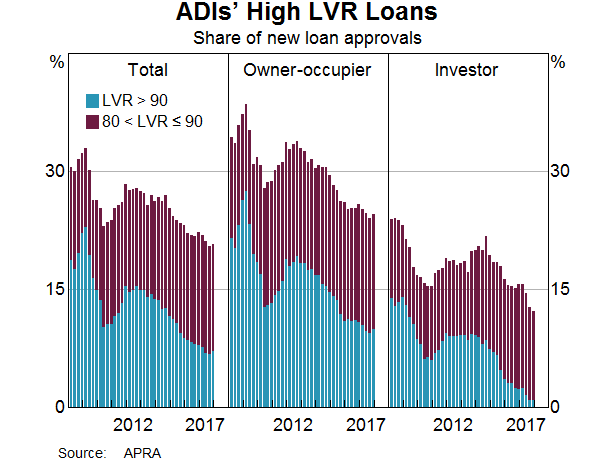
But investors have less incentive than owner-occupiers to pay down their debt. As noted above, many take out interest-only loans so that their debt does not decline over time. If housing prices were to fall substantially, therefore, such borrowers might find themselves in a position of negative equity more quickly than borrowers with an equivalent starting LVR that had paid down some principal. Indeed, the macro-financial risks are potentially heightened with investor lending. For example, since it is not their home, investors might be more inclined to sell investment properties in an environment of falling house prices in order to minimise capital losses. This might exacerbate the fall in prices, impacting the housing wealth of all home owners. As investors purchase more new dwellings than owner-occupiers, they might also exacerbate the housing construction cycle, making it prone to periods of oversupply and having a knock on effect to developers.
Data from the Australian Taxation Office (ATO) provide some information on housing investors. While not particularly timely, these data show that the share of taxpayers who are property investors has increased steadily over the past few years. In 2014/15, around 11 per cent of the adult population, or just over 2 million people, had at least one investment property and around 80 per cent of those were geared (Graph 10). Most of those investors own just one investment property but an increasing number own multiple properties. There has also been a marked increase in the share of geared housing investors who are over 60. These factors do not necessarily increase the risk of financial stress but they bear watching.
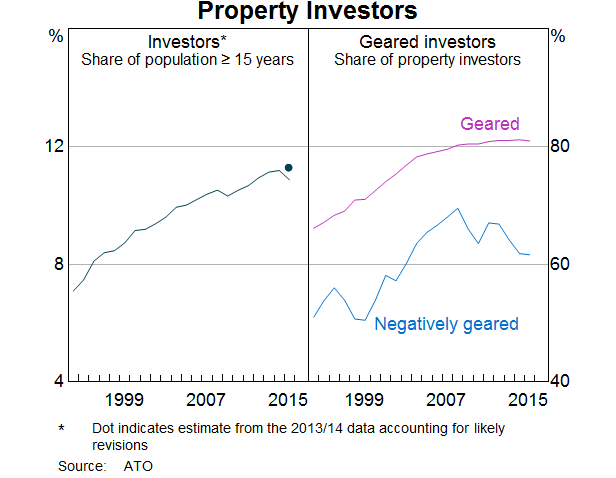
The recent increases in interest rates on investor loans, in response to APRA's measures to reduce the growth in investor lending, has probably affected the cash flows of investors. Interest rates on outstanding variable-rate interest-only loans to investors have increased by 60 basis points since late 2016. However, over the past few years, lenders have been assessing borrowers' ability to service the loan at a minimum interest rate of at least 7 per cent. So while interest rates and required repayments have likely risen, many borrowers should be relatively resilient to the recent changes.
Furthermore, a large proportion of interest-only loans are due to expire between 2018 and 2022. Some borrowers in this situation will simply move to principal and interest repayments as originally contracted. Others may choose to extend the interest-free period, provided that they meet the current lending standards. There may, however, be some borrowers that do not meet current lending standards for extending their interest-only repayments but would find the step-up to principal and interest repayments difficult to manage. This third group might find themselves in some financial stress. While we think this is a relatively small proportion of borrowers, it will be an area to watch.
Conclusion
The historically high levels of mortgage debt in Australia raises questions about the resilience of household balance sheets to a change in circumstances and the ability of the financial system to absorb a widespread increase in household financial stress. The information we have suggests that, while there are some pockets of financial stress, the overall level of stress among mortgaged households remains relatively low. Furthermore, the banking system is strong and well capitalised, and is supported by prudent lending standards. The risks to financial stability from this source therefore remain low although we will need to keep an eye on developments. Appropriately prudent lending standards will continue to play an important role in ensuring that the financial system remains stable and households borrow responsibly.
The original article can be found here.
